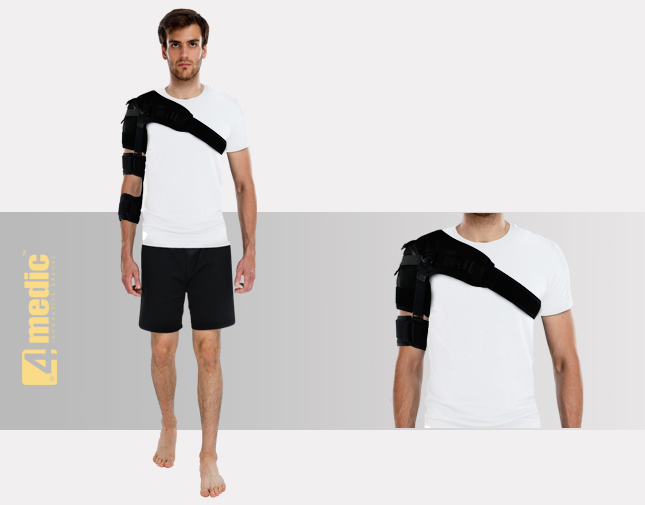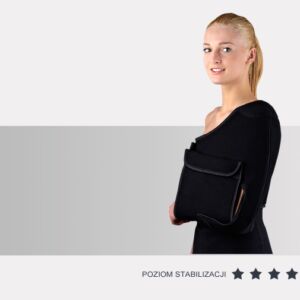NEUROLOGICAL UPPER LIMB ORTHOSIS WITH SLINGS AND SHOULDER CORRECTION FUNCTION
Stroke is often the cause of hemiplegia, also called hemiplegia. It causes paresis of the muscles on one side of the body. This type of damage is characterized by the fact that it appears on the side opposite to the one on which the brain injury occurred. This is due to the fact that the corticospinal pathways are crossed, they run from one hemisphere to another. Therefore, when the injury affects, for example, the left hemisphere, then muscle paralysis occurs on the right side.
Hemiplegia is characterized by severe muscle weakness on one side of the body, but the specific symptoms may vary greatly from patient to patient. The most common symptoms of hemiplegia are the following:
-
Difficulty walking
-
Difficulty grasping objects
-
Problems with balance when standing or walking
-
Muscle spasms
-
Increasing muscle stiffness
-
Paralysis of the limbs
Stroke often occurs without warning. Someone laughs, talks, performs daily household chores and suddenly loses his balance or grabs his head as if he stumbled. Sometimes he falls, speaks incomprehensibly or complains of visual disturbances. Such symptoms should not be underestimated, because they may be symptoms of a stroke.
Another type of abnormality leading to paresis of the upper limb is damage to the brachial plexus, which consists of a set of nerves that control the movement of the shoulder, arms, hands and fingers. In the case of falls, traffic accidents and sports injuries, head and neck injuries may occur, which very often causes the nerve of the plexus to be interrupted and impulses cut off. Particularly dangerous sports exposed to damage to the brachial plexus are: rugby, wrestling, boxing, American football, diving, skiing, hang gliding and football. Symptoms of brachial plexus injury include lack of control of the muscles of the arm, hand and wrist, flaccid hand as well as lack of feeling of the arm or the hand itself.
INDICATE:
-
hemiplegia
-
shoulder injury (dislocation of the head of the humerus)
-
brachial plexus injury
PRODUCT FEATURES:
-
Neurological shoulder orthosis MASTER-03 is available in two versions, depending on the location of the brachial plexus damage:
upper paralysis (Erb-Duchenne type) concerns the level of C5, C6 (occurs in approx. 60%), in other words, it is damage to the upper trunk, which is responsible for the movements of the upper part of the hand, i.e. shoulder and elbow. In this situation, the MASTER-03 orthosis with a short arm sling can be used,
lower paralysis (Dejerine-Klumpke type) concerns the level of C8-Th1 (occurs least often in approx. 5%), in other words, it is damage to the lower trunk, which is responsible for the lower part of the hand, i.e. hand and wrist. In this situation, the MASTER-03 orthosis with a long suspension of the arm and forearm should be used,
total/mixed paralysis (Erb-Duchenne-Klumpke type) is damage to the entire plexus at the level from C5-Th1. It is also the most common damage. With this paralysis, it is accompanied by a significant shortening and reduction of the hand and hand. In this situation, the MASTER-03 orthosis with a long suspension of the arm and forearm should be used.
-
The orthosis is made of breathable and pleasant to the skin material
-
The orthosis consists of:
-
shoulder part equipped with a detachable shoulder sleeve and a universal chest belt with a relieving axillary pelota equipped with a shoulder lift adjustment system and its adduction and visit.
-
arm sling with silicone anti-slip system and universal Velcro fastening,
-
long arm and forearm sling consisting of a silicone anti-slip system and a universal Velcro clasp.
-
The orthosis also has rotary mounts for attaching upper limb slings,
-
Constructed from three-layer waterproof AirDistance II material with a very strong polyamide cover fabric with a self-adhesive function, relieving EVA foam and polyamide 3D spatial knitwear.
PRODUCT ADVANTAGES:
-
Excellent support for the therapy of upper limb paralysis,
-
Repositions the forearm, shoulder or shoulder joint,
-
Stabilizes the shoulder joint,
-
It has an analgesic effect and brings relief,
-
Prevents repeated injuries of the shoulder, muscles, tendons and nerves,
-
Improves the patient’s posture,
-
Corrects the position of the head of the humerus in the acetabulum, thus reducing the cause of pain,
-
Helps to stabilize the arm and put it back in the right place,
-
Provides pronounced relief, relieves pain and leads to better overall body posture,
-
Thanks to the extensive shoulder element with the axillary pelota covering a large part of the body, the patient, despite the disturbed deep sensation, can locate the limb and “feel” the shoulder with the arm, which affects the effect of rehabilitation,
-
The mechanism of regulating shoulder elevation and its visit and adduction allows the limb to be located in an anatomical place and achieve an appropriate movement pattern during rehabilitation,
-
Excellent isolation of the impact of the orthosis metal elements on the patient’s body thanks to the semi-rigid perforated EVA relief foam,
-
Facilitated adjustment of products through self-adhesive function,
-
Free air flow, which oxygenates the skin and causes sweat to evaporate much faster thanks to the internal 3D fabric with a spatial structure
REMEMBER: The earlier the rehabilitation started, based on correct movement patterns (which is provided by the MASTER-03 shoulder orthosis), the greater the chance for a quick recovery!
Reh4Mat
In the online store








